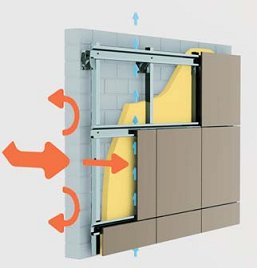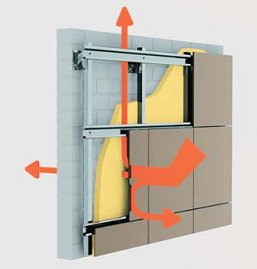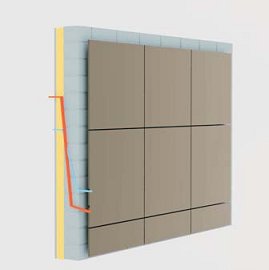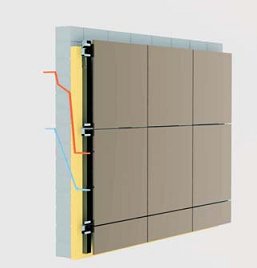Properties and advantages of Frontsystem
Propiedades y ventajas de Frontsystem
02.2
Una
parte del calor radiante
es reflejado
hacia el exterior. La parte de calor que se
filtra a la cámara, activa el efecto chimenea,
por lo que sólo una pequeña parte del flujo
de calor es absorbida por el edificio, y en el
caso que el aislamiento esté correctamente
instalado, el calor absorbido por el edificio
es nulo.
El efecto de reflexión del calor,
puede aumentarse utilizando colores claros
en el paramento exterior.
Part of the radiant heat is reflected outwards.
The part
of the
heat that
filters
into the
chamber produces the stack effect, which
is why only a small part of the heat flux is
absorbed by the building
and, when the
insulation is correctly installed, no heat is
absorbed by the building. Heat reflection
may be
further
enhanced by
using light
colours in the outer cladding.
En épocas de frío, el muro portante actúa
como acumulador del calor interior que le
es más difícil transmitirlo al exterior debido
a la capa aislante, por tanto, lo devuelve al
interior. En este caso, la circulación de aire
en
la
cámara ayuda
a
la
estabilización
térmica
del
conjunto
de
la
edificación.
In cold periods, the load-bearing wall acts
as an accumulator of the inner heat that it
transmits with greater difficult to the outside,
owing to the insulating layer, and that is
therefore returned inwards. In this case, the
air circulation in the chamber contributes to
the thermal stabilisation of the building as
a whole.
Debido
a las
mejoras
en el rendimiento
energético del edificio se reduciría entre el
25 y 40% del consumo de energía destinada
a
la
climatización
(calefacción
y
refrigeración).
As a result of the improvements in building
energy efficiency, energy consumption for
air conditioning
(heating and cooling)
is
reduced
by
between
25
and
40%.
2
Comportamiento en entornos fríos
Performance in cold environments
1
Comportamiento en entornos cálidos
Performance in warm environments
3
Ahorro energético
Energy saving
13
Condensation occurs when the air is cooled to such an extent that it reaches its dew point temperature. When a ventilated facade system
and its corresponding thermal insulation have been installed, it will be observed that condensation does not form, since the curve of water
vapour pressure in a saturated ambient does not intercept the curve of water vapour pressure in a wet, though not saturated, ambient.
4
La condensación se produce cuando el aire
se enfría hasta tal punto que alcanza su
temperatura de rocío. Con la colocación de
un
sistema
de
fachada
ventilada
y
su
correspondiente aislante térmico se puede
observar que no se forman condensaciones
ya que la curva de la presión del vapor de
agua en ambiente saturado no intercepta la
curva generada por la presión ejercida por
el vapor de agua en ambiente húmedo, pero
no saturado.
Eliminación de la condensación superficial
Elimination of surface condensation
La
corrección
de
los
puentes
térmicos
mediante
la
aplicación
de
elementos
aislantes permite reducir notablemente las
dispersiones globales incluso en un 30%),
por lo que se obtienen grandes ventajas de
tipo energético.
The suppression of thermal bridges by the
application of insulating elements provides
a notable reduction in the overall dispersions
(up to even 30%), with great energy-benefits.
5
Eliminación de puentes térmicos
Elimination of thermal bridges
14



